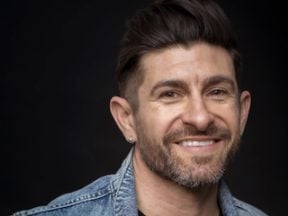Jon Shanahan destroys the myth that founders make lousy employees. He co-founded Stryx, a men’s cosmetics provider, and has now remade TRX, the storied exercise equipment company.
He joined TRX in late 2022 amid a post-Covid hangover and a stale legacy brand. Fast forward to late 2025, and TRX is refreshed and flourishing, thanks in part to Jon’s entrepreneurial mindset.
While at Stryx, Jon appeared on the podcast twice, in 2020 and 2022. In this latest conversation, he shares transitioning to a large corporation, the challenges of reviving a brand, and more.
Our entire audio is embedded below. The transcript is condensed and edited for clarity.
Eric Bandholz: What are you doing now?
Jon Shanahan: I transitioned to TRX Training as vice president of marketing at the end of 2022. TRX is the global training brand recognized for its distinctive black-and-yellow suspension straps, a bodyweight training system found in nearly every gym.
You helped us at Stryx when we launched into Target in 2022. Stryx and Beardbrand entered during a major aisle reset, which eliminated many existing brands. Four or five other companies launched alongside us, but by 2023, Target had removed all of us — even though our sales exceeded Target’s benchmarks.
TRX filed for bankruptcy in early 2022, following the collapse of the fitness boom. During the pandemic, anything fitness-related was popular, and TRX was everywhere — Nordstrom, REI, Hy-Vee. However, demand eventually dropped, and the company overextended itself.
In August, founder Randy Hetrick reacquired TRX. His goal was to modernize a 20-year-old global brand for a new generation. Initially, I wasn’t keen on moving to Florida from my home in Pennsylvania, but I eventually did, and I joined the team.
My initial focus was brand strategy. I conducted a global study — TRX operates in 80-plus countries — to clarify its identity and market role. That led to a complete refresh, including a new logo. Randy supported it, and it’s been well received.
Soon, I took over all marketing and later expanded into ecommerce and in-store retail, along with TRX’s commercial and education businesses. Unlike Stryx, where I was the face of the brand, here I’m behind the scenes, scaling a legacy brand. TRX had diehard fans, so the challenge is guiding that loyalty into growth and innovation.
Bandholz: You created a new TRX logo. Did it receive a backlash?
Shanahan: Surprisingly, no. In Europe, we have 25 long-time distributors who’ve supported TRX since Randy first sold straps himself. I was intentional in the redesign — it had to feel like TRX but with a modern edge. The heritage mattered, but it needed a fresh approach.
The decision came while we were building a new headquarters in Delray Beach. Seeing the old logo in the renderings, I realized that if we hadn’t changed it then, we never would. It marked a new era for TRX.
The update wasn’t drastic. We retained the iconic “TRX” name and black-and-yellow colors, while refining the design. Rolling it out took time because of our extensive SKUs. We phased it in digitally first, then packaging and straps, keeping costs down.
We also ensured stakeholders were on board. Distributors, retailers, and internal teams were the first to preview it. Notably, the redesign was by the original TRX designer — the same one who worked with Randy in his garage. Bringing him back gave the refresh authenticity.
The reception was smooth. For us, the new logo signaled TRX’s return and future direction.
Bandholz: You oversee retail, direct-to-consumer, and Amazon. How do you prioritize and align those channels?
Shanahan: Each channel requires a different approach. Amazon is a daily knife fight. You need competitive, lower-priced SKUs to stand out. Our ecommerce site, by contrast, is the brand’s showcase. That’s where we feature premium products and position TRX as the leader.
We manage channel conflict with multiple SKUs. For example, we sell 18 versions of the suspension trainer: two premium models on our stie, three “good-better-best” options on Amazon, and value-driven versions in physical retail.
Retail messaging is sport-specific, such as golf, pickleball, and tennis, since shoppers want programs tied to their favorite activities. On Amazon, people mostly search for “home gym” or “home strength,” so we optimize our keywords accordingly.
Our site emphasizes heritage — “the iconic strap” — and certain high-ticket products, such as our 20- and 40-pound weight vests. They wouldn’t sell on Amazon.
Beyond consumer channels, we’re expanding into commercial and educational sectors. That means learning what gyms, trainers, and pros need and then translating those insights back to consumers. After two years, I feel we’ve hit a stride — 2026 will be about strengthening those cross-channels.
Bandholz: You’ve transitioned from an entrepreneurial role at Stryx to a corporate environment.
Shanahan: Founders bring a unique skill set, but the transition isn’t always easy. For those early in their careers, I often recommend starting with an established company. You’ll get paid to make mistakes and learn valuable lessons. I spent years at Apple and a software firm before starting YouTube projects and co-founding Stryx. I can apply those lessons in a corporate role.
Joining an existing team, I leveraged my finance literacy while also focusing on listening. The first six months ideally are dedicated to understanding how things work before making any changes.
Clear communication is critical. I talk daily with leadership to share issues and align on direction, then relay that to the team. It feels like being a founder again — selling the vision, gathering feedback, and building buy-in.
Bandholz: Let’s talk about licensing. How can a brand establish those high-margin collaborations?
Shanahan: Licensing comes in two forms. In-licensing is what we did with The Ohio State University. We created a TRX strap branded with that school’s name, paid royalties, and benefited from the recognition. Out-licensing is the reverse: putting TRX on products we don’t manufacture. For that to work, our brand must carry strong market credibility.
TRX is authentic in functional training, so extending into other training products makes sense. It allows consumers to choose TRX-branded items over generic private-label alternatives at stores such as Dick’s Sporting Goods. That’s a direction we’re exploring for 2026.
We’ve had inbound interest from various companies. For example, Dick’s fitness section features Everlast resistance bands and New Balance jump ropes — products manufactured by third-party companies, which pay a 5–10% royalty. Walmart is similar, with about 60% of its fitness gear being licensed brands and 40% private label.
Bandholz: Where can people follow you, buy some TRX bands?
Shanahan: We’re at Trxtraining.com. Hit me up on LinkedIn.





